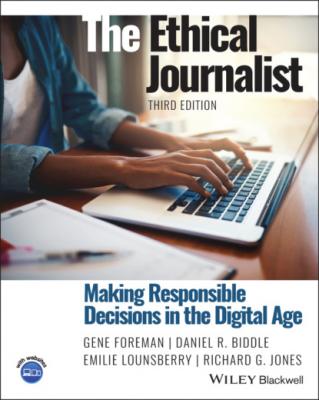The Ethical Journalist. Gene Foreman
Чтение книги онлайн.
Читать онлайн книгу The Ethical Journalist - Gene Foreman страница 33
 Letson had to decide whether to continue reporting on a street brawl between two groups of demonstrators, or to try to save someone being assaulted. Whether or not he was “the best person or the only person,” he could see that no one else was intervening.
Letson had to decide whether to continue reporting on a street brawl between two groups of demonstrators, or to try to save someone being assaulted. Whether or not he was “the best person or the only person,” he could see that no one else was intervening.
Rachel Smolkin, who wrote about journalists who intervened in Katrina’s aftermath, offers this guidance:
Follow your conscience. Your humanity – your ability to empathize with pain and suffering, and your desire to prevent it – does not conflict with your professional standards. Those impulses make you a better journalist, more attuned to the stories you are tasked with telling.
If you change an outcome through responsible and necessary intervention because there’s no one else around to help, so be it. Tell your bosses, and when it’s essential to a story, tell your readers and viewers, too.
Remember, though, that your primary – and unique – role as a journalist is to bear witness. If you decide to act, do so quickly, then get out of the way.32
Notes
1 1 Rachel Smolkin, “Off the sidelines,” American Journalism Review, Dec.–Jan. 2006.
2 2 Ibid.
3 3 Ibid.
4 4 Ibid.
5 5 Society of Professional Journalists, “SPJ cautions journalists: report the story; don’t become a part of it,” news release issued Jan. 22, 2010.
6 6 This section of the chapter is based on Sonia Nazario, “Ethical dilemmas in telling Enrique’s story,” Nieman Reports, Fall 2006, 27–29.
7 7 Mark LaFlamme, “Fugitive caught in flash,” Lewiston (Maine) Sun Journal, Oct. 4, 2007.
8 8 Paul Martin Lester, “Think fast,” News Photographer, Nov. 2007.
9 9 Russ Dillingham in an email to Shannon Kahle, Apr. 30, 2008.
10 10 Lester, “Think fast.”
11 11 Philip Seib and Kathy Fitzpatrick, Journalism Ethics (Fort Worth, TX: Harcourt Brace, 1997), 122.
12 12 Bruce W. Sanford, Don’t Shoot the Messenger: How Our Growing Hatred of the Media Threatens Free Speech for All of Us (New York: Free Press, 1999), 128.
13 13 “TV interview helps end Texas escape standoff,” The Associated Press, Jan. 24, 2001.
14 14 Eric Singer in an email to Shannon Kahle, July 8, 2008.
15 15 “TV interview helps end Texas escape standoff.”
16 16 Singer in an email to Kahle.
17 17 Clifford G. Christians, Kim B. Rotzoll, Mark Fackler, Kathy Brittain McKee, and Robert H. Woods Jr., Media Ethics: Cases and Moral Reasoning, 7th edn. (Boston: Allyn & Bacon, 2005), 61.
18 18 Gene Roberts and Hank Klibanoff, The Race Beat: The Press, the Civil Rights Struggle, and the Awakening of a Nation (New York: Alfred A. Knopf, 2006), 159–160.
19 19 Ibid., 161.
20 20 David Margolick, “Through a lens, darkly,” VanityFair.com, Sept. 24, 2007.
21 21 Carla Fine, letter to the editor of The New York Times, Sept. 30, 2018.
22 22 Department of Defense memorandum, “Subject: Public Affairs guidance on embedding media during possible future operations/deployments in the US Central Commands (CENTCOM) area of responsibility (AOR),” Feb. 10, 003.
23 23 Jim Bettinger, “Detail provided by embedding was invaluable, and haunting,” a report for the American Society of Newspaper Editors, June 4, 2004.
24 24 Jules Crittenden in an email to Shannon Kahle, Apr. 6, 2008.
25 25 Ibid.
26 26 Bettinger, “Detail provided by embedding was invaluable, and haunting.”
27 27 Crittenden in an email to Kahle.
28 28 Crittenden in an email to Gene Foreman, July 16, 2008.
29 29 David Zucchino, Thunder Run: The Armored Strike to Capture Baghdad (New York: Atlantic Monthly Press, 2004), 57–58.
30 30 Bettinger, “Detail provided by embedding was invaluable, and haunting.”
31 31 Bob Steele in a telephone interview with Gene Foreman, Jan. 15, 2008.
32 32 Smolkin, “Off the sidelines.”
Point of View
Journalists Are Humans, Too
The reporters’ actions … got a vulnerable person out of harm’s way.
By Halle Stockton
JOURNALISTS ARE TAUGHT to avoid conflicts of interest, and we try to learn how to observe a situation like a fly on the wall.
Even so, reporters occasionally become part of the story.
The public usually hears about plagiarism scandals and journalists refusing to name sources (or complaining about their hotel arrangements at the Olympics).
But there are reporters in communities across the nation who are faced with less‐publicized challenges of how to abide by a code of ethics while also remaining human.
An example of this occurred in Pennsylvania with two Philadelphia Daily News reporters. Wendy Ruderman and Barbara Laker were contacted by an anonymous caller with concerns about the safety of Clarence Shuford, a 47‐year‐old man with physical and intellectual disabilities.
They learned Shuford and the actions of his caregiver, Barbara Floods, were not being supervised closely, so they visited the home and asked to go inside.
Floods invited the reporters up to her second‐floor apartment, where a barefoot Shuford, dressed in a plaid shirt and gray denim pants, sat meekly on a leather sofa next to a table covered with dusty prescription‐pill bottles and an open bag of adult diapers.
His eyes were bloodshot and puffy, rimmed underneath with inky black circles. His bottom lip appeared swollen. He looked unkempt, with bits of white lint stuck to his closely cropped hair. Small flies circled his head.
Ruderman and Laker toured the apartment, noting the food in the refrigerator,